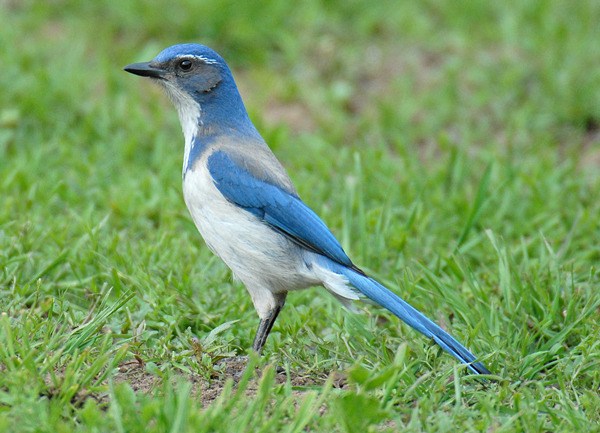The Whidbey Audubon Society rare bird report recently announced that a Western scrub jay had been observed near Clinton, not far from where I live. I’ve kept my bird feeders full and my eyes peeled, but haven’t yet seen this out-of-territory species. I’m watching for a sky blue bird with a grey back, no crest and pale underparts.
Western scrub jays have been expanding their range north from drier regions of the Southwest since the 1970s. They’ve established themselves near Portland and in the very southern part of Puget Sound, particularly around Joint Base Lewis McChord. The birds don’t migrate, but younger birds may disperse, particularly in the fall. They’ve been sighted on Whidbey in the past and may become a common bird here in the future.
In the meantime, I’ll continue to enjoy our common resident, the Steller’s jay. That cobalt blue, black-crested, saucy corvid swoops into my seed feeder sending all the little birds and half the seed flying off into the air.
I used to feed them peanuts, but that nearly became a full time job and, like kids in a cafeteria, if I didn’t get the food to them right away, they’d start squawking.
All corvids (crows, ravens and jays) are remarkably intelligent.
Back when I was feeding the Steller’s jays, I’d set peanuts on the deck railing. They’d watch from the roof and wait for me to go back inside before descending for their treats.
One day, instead of retreating, I paused for a few minutes to enjoy the warm afternoon. First the jay scolded me with its own alarm call, trying to get me to leave so that it could fly down and grab the peanuts. Then, after several more unsuccessful tries to scare me off, it pulled out its ace-in-the-hole, the alarm call of the top predator in the neighborhood.
I watched that Steller’s jay belt out an exact mimic of a bald eagle’s call. If I hadn’t been standing close enough to see its beak moving, I wouldn’t have believed the call actually came from the jay.
Steller’s jays are rather common mimics. There’s one near Langley Middle School that performs a perfect red-tailed hawk mimic.
I’m particularly excited about having a Western scrub jay visiting in the neighborhood because of the work of bird behaviorist Nicola Clayton, who has been studying that species.
In the fall these jays each stash 3,000-5,000 nuts and acorns. Months later they return to consume their food cache. But they do not just stash the nuts randomly. To learn more about the process, Professor Clayton devised an experiment that proves the jays employ future planning when it comes to when and where they hide their horde.
Clayton’s test involved setting up a large enclosed aviary for her flock of captive jays. At one end of the aviary was a room that she called a Bed and Breakfast. That room had a bountiful supply of breakfast acorns. A separate room at the far end of the aviary was a stripped down Motel 6 with no food.
On separate occasions Clayton isolated the jays in just the B & B or just the Motel 6. Later all the doors were opened and the birds could fly freely throughout the aviary. During this open-door time, the jays took the opportunity to stash food in the Motel 6 room, but didn’t bother to stash in the B & B room. According to Clayton, they must have remembered the hungry hours enclosed in the Motel 6 and wanted to prevent that from happening in the future.
Clayton called that future planning, and I agree.
If or when those clever scrub jays make it to Whidbey Island, we’ll likely enjoy them as much as we do our old friend, the Steller’s jay.
Frances Wood can be reached at wood@whidbey.com. Craig Johnson is at Craigjohnson@whidbey.com.


